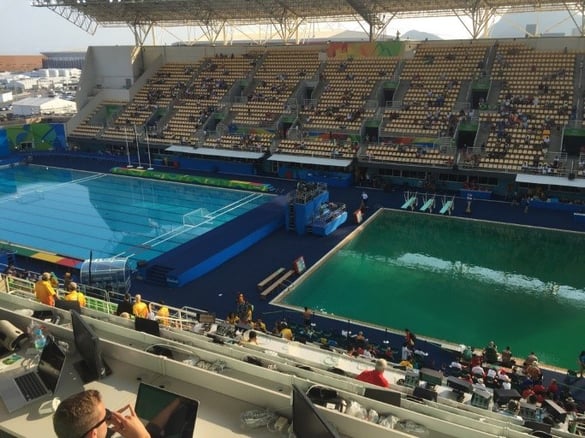
Image courtesy @mattmajendie (Twitter)
The Olympic swimming and diving competitions are some of the most popular events that capture the attention of fans worldwide. The precise and acrobatic skills of the divers, which usually culminates with entry into crystal blue pools, didn’t quite work out that way this year. The divers were there—but the water clarity wasn’t.
So, when on Tuesday, August 9, TV coverage showed a wide shot at the Maria Lenk Aquatics Center, it revealed a side-by-side, stark comparison of its two pools. The Olympic-sized pool was crystal blue while the diving pool appeared to be tinted with a deep green hue, despite it appearing normal just a day earlier. According to Olympic officials and media reports, an unauthorized dump of 80 liters of hydrogen peroxide destroyed the chlorine in the water. Olympic officials called the incident embarrassing—they had to drain the water polo pool and refill it to continue with the competition while they continued to treat the diving pool.
A Teachable Moment
What can pool operators learn from this high-profile pool maintenance blunder? Namely, that proper training, maintenance, and record keeping are crucial to maintaining safe and pristine looking pool water. Adoption and rigorous adherence to established standards of practice can greatly lessen the chance of something like this happening to your pool.
Stay Out of Trouble with Accu-Tab
If you’re a regular Keeping Tabs reader, you know all too well how well-balanced water can help you avoid all sorts of issues with water quality. In fact, we issued an entire research study on how to meet the standards of health inspectors, who routinely test aquatic facilities of all sizes in accordance with local and state regulations.
In our report, water quality issues are a key focus for public safety in swimming facilities and it is clear that local health inspectors recognize this importance. For example, ninety-eight percent (98%) report they test pH during their inspections and ninety-seven percent (97%) report they always check free and total chlorine.
Finding Balance
The Accu-Tab system facilitates precise chlorine delivery and aids in the prevention of algae and bacterial growth. However, just having chlorine in the pool isn’t the full story, as pH is also crucial.
The Accu-Tab system helps pool operators more easily achieve a balanced pH compared to competitive solutions like sodium hypochlorite; the Accu-Tab system features a more neutral pH of 10.5, compared to 12% chlorine bleach’s pH of 13. This supports better pH balance of water and less need for the addition of acid. pH is a primary metric in supporting chlorine effectiveness. When the pH of pool water is high (above 7.8), chlorine effectiveness starts to become inhibited. When pH is low (below 7.0), its effectiveness increases—but so too does the possibility of irritation to swimmers’ eyes and skin.
The acceptable range for pH is between 7.2 to 7.8. This range achieves the right balance of swimmer comfort and chlorine efficacy. Of course, other factors, like alkalinity, temperature, and bather loads can also affect water balance. However, the two main factors begin with the right amount of chlorine in the pool and proper pH. Accu-Tab’s three-inch calcium hypochlorite tablets also help maintain the water’s total alkalinity to prevent “pH bounce,” which occurs when pH jumps from high reading to low ones based upon an insufficient alkalinity level (80-100 ppm).
When it comes to chlorine delivery and water balance, the Accu-Tab system has been on the front line of pool care for more than 20 years, keeping water blue, safe and out of the headlines—for all the right reasons.
Learn how to make your water medal-worthy!
Download Our Looking for Trouble Report!
Learn the Accu-Tab difference!
About the Author
Christopher M. Kareis is a Development Chemist II at Westlake Water Solutions, where his research focuses on the development of new water treatment technologies. He obtained his Ph.D. from The University of Utah, where he was also a Postdoctoral Fellow in a National Science Foundation Materials Research Science & Engineering Center.

